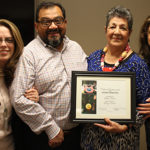Posted: 6/06/03
LifeWay Family Bible Series for June 22
The Acts 2 church is a good measuring stick
Acts 2:42-47; Ephesians 4:1-6
By Tim Owens
First Baptist Church, Bryan
In American society, individualism is championed. It is true each individual must decide whether he or she will allow Jesus Christ to be Savior and Lord of life. It is true each person must give account of himself to God (Romans 14:12). However, individualism can create loneliness and isolation.
Individualism can result in fractured relationships, broken homes and divided churches. Church members may come and go to worship services while never having experienced significant and meaningful community with other believers. Acts 2:42-27 and Ephesians 4:1-6 help believers to evaluate the quality of the fellowship in their church and to make adjustments so fellowship is strengthened.
 |
In Acts 2:42-47, the church is functioning under the effects of the day of Pentecost. These verses present a beautiful picture of a Spirit-driven church. What does a Spirit-driven church look like? First, the Spirit-driven church is a teaching church. In Acts 2, the members devoted themselves to the apostles' teaching. When the Holy Spirit came upon the church, the members engaged their minds to discover more about their new-found faith in Jesus Christ.
Current churches put much emphasis on corporate worship and rightfully so, but not to the point of diminishing the teaching of Christ and his word. The Spirit-driven church is a church where the Scriptures are taught, heard, learned and practiced.
Second, the Spirit-driven church is a loving church. In Acts 2, the members devoted themselves to fellowship. The word is “koinonia.” It refers to the common life of the church, the experiences believers share together, the common love that binds believers together and the common commitment to submit to the lordship of Jesus Christ. New Testament fellowship is when believers are sharing with each other the person whom they all adore, the Lord Jesus Christ.
Whether believers meet in a large worship setting, in small groups or in ones and twos, the person of Christ is the most dominant topic of conversation. Koinonia is very close to another Greek word, “koinoni-kos,” which is the Greek word for generous. Luke could have had this word in mind when he was talking about koinonia. Believers were sharing life together. They were pooling their material resources together. When there were needs within the fellowship of the church, the members were determined to meet those needs.
Third, the Spirit-driven church is a worshipping church. In Acts 2, the members devoted themselves to the breaking of bread and prayer. Their fellowship culminated in corporate worship. The worship of the New Testament church was both in the temple courts and in their homes. They worshipped in one large gathering, and they worshipped in small groups. Their worship was both joyful and reverent. They worshipped with glad and sincere hearts, and as they worshipped, they were filled with awe.
Fourth, the Spirit-driven church is a witnessing church. The last sentence in Acts 2:47 reads: “And the Lord added to their number daily those who were being saved.” The early church was not so preoccupied with teaching, loving and worshipping that they failed to witness. Where the Holy Spirit is free to control the church, He will always create a witnessing church.
Believers can evaluate their church by the Acts 2 church. It was a church related to their teachers in submission to the Scripture. It was a church related to one another through loving fellowship. It was a church related to God through joyful, reverent worship. It was a church related to the world through gospel witness.
Ephesians 4:1-6 gives practical instruction as to how the church can guard the unity of its fellowship. While the Holy Spirit creates unity in the church, believers have the responsibility to guard it and strengthen it through humility, gentleness, patience and forgiveness.
In God's sight, everyone who receives Jesus Christ as the Savior and Lord of life is a part of one body. There can be different denominations, different traditions and different churches who align themselves with different church/mission-support systems. However, this passage teaches that people who have embraced by faith the one Spirit, the one Lord Jesus Christ and the one God constitute the one family of God.
The question is: Are believers eager to find a visible expression of Christian unity? It is at this very point that the mission of the church is at stake. Mission and unity hang together. When believers do not demonstrate unity in the person and mission of Jesus Christ, their witness will not be heard, and deservedly so. How can Christians preach a message of reconciliation if they are not willing to be reconciled to each other in Christ?
Unity does not mean unity at any cost. Unity does not mean diluting the essentials of the Christian faith. Unity does not refer to a single church or denominational structure. Unity does not mean we must agree on everything. But unity does mean believers magnify the things they hold in common, that believers value each other and declare a common commitment to the Lord Jesus Christ.
Question for discussion
![]() Looking at these characteristics of the Acts 2 church, what can you do to help your church better exemplify Christ to your community?
Looking at these characteristics of the Acts 2 church, what can you do to help your church better exemplify Christ to your community?














We seek to connect God’s story and God’s people around the world. To learn more about God’s story, click here.
Send comments and feedback to Eric Black, our editor. For comments to be published, please specify “letter to the editor.” Maximum length for publication is 300 words.